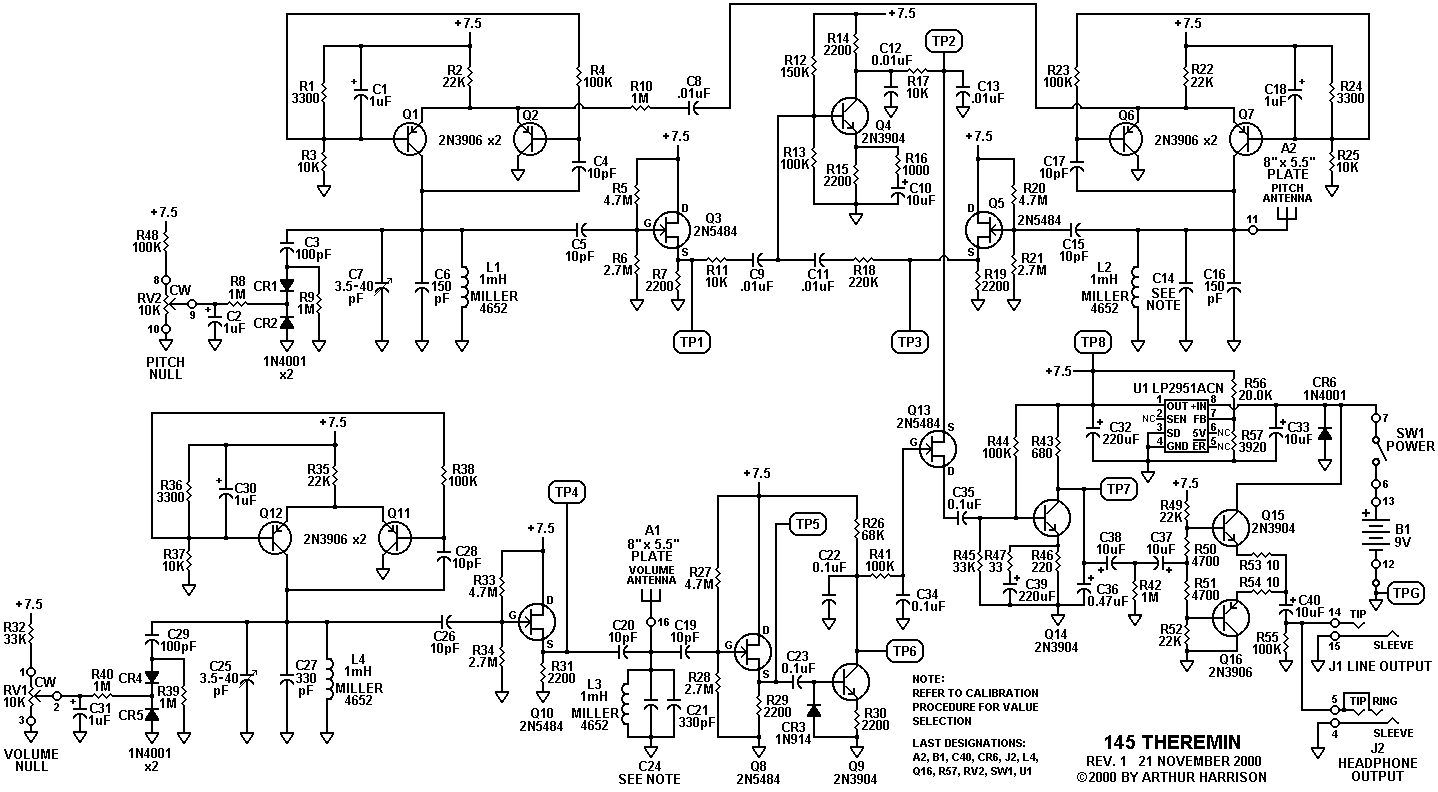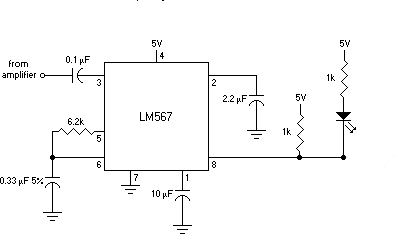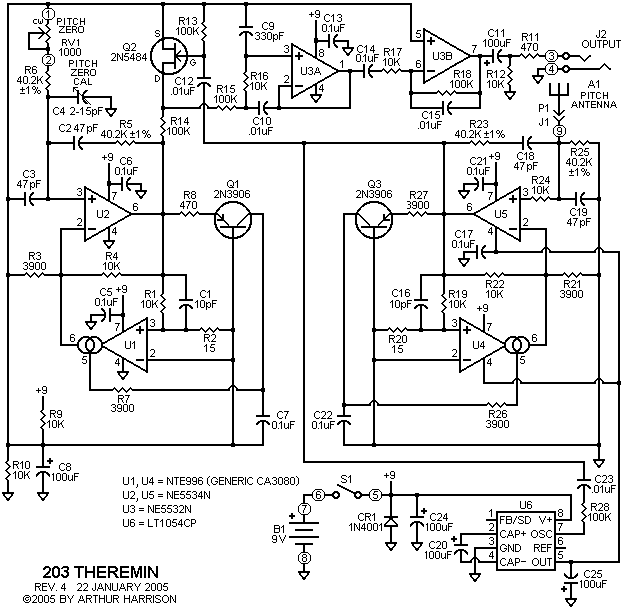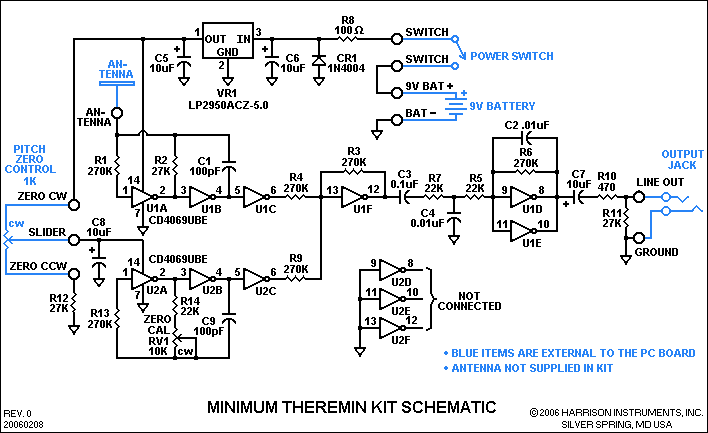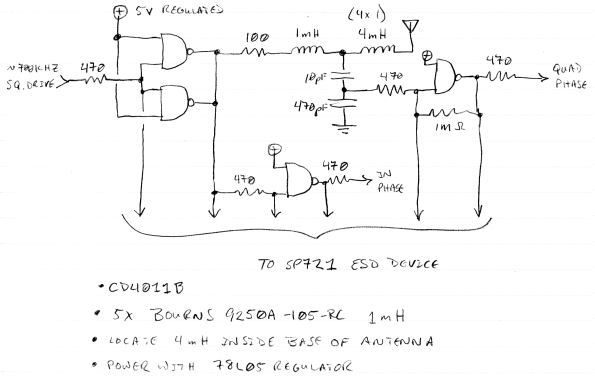
theremin bamttech
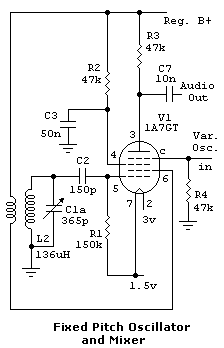
This document outlines the various sections involved in the implementation of BAMTRAT. Many component values were determined experimentally to align with personal preferences. As with constructing acoustic instruments, there is considerable scope for experimentation and customization in electronic instruments, particularly theremins.
Additional information on capacitors indicates that ceramic capacitors, especially of the NPO variety, can be beneficial. While ceramic capacitors are generally regarded as less than ideal for high-fidelity audio applications, they are excellent for RF applications due to their minimal capacitance drift with temperature and low equivalent series inductance compared to foil and film capacitors.
The circuit features a simple yet effective "Battery Eliminator" that supplies the necessary voltages (+80V, +3V regulated, and -7.5V) required for BAMTRAT operation. It utilizes two transformers salvaged from 6V, 0.3A wall-wart supplies to step down the voltage for the filament and C- supplies, while stepping up to provide the B+ voltage. The 6V AC output is full-wave rectified by the positive side of bridge D2-5, filtered by capacitor C15, and regulated by an adjustable regulator (LM317), supplying regulated 3V for the series-parallel connected tube heaters.
Incorporating six 1N4002 diodes, designated in blue, is highly recommended as protection against the removal of tubes from their sockets, preventing the voltage from exceeding approximately 1.8V. The negative side of the bridge supplies the negative bias voltage for the power amplifier, filtered by C14. Given the low current draw from this supply, even the 47 µF capacitor is considered excessive. The stepped-up B voltage is rectified by bridge D6-9 and filtered through a two-stage filter comprising capacitors C17, C13, and resistor R10. The power amplifier, which draws the most current and is less sensitive to ripple, is powered from the first filter section.
Voltage-critical RF oscillators are powered by a simple regulator made up of resistor R13 and zener diode D1. It is important to note that this circuit depends on the self-limiting characteristics of the specified wall-supply transformers to achieve the correct B+ voltage. If an alternative method is employed, it is crucial to ensure that the raw B+ voltage does not exceed approximately 90 volts under a 20 mA load. Additionally, voltage may temporarily spike to around 160 volts while the tubes warm up; therefore, the voltage ratings of filter capacitors should not be underestimated.
An undocumented enhancement includes the addition of small capacitors (e.g., 3000 pF) across each of the eight rectifier diodes, which can mitigate a 60 Hz modulation that occasionally affects RF circuits. The power amplifier section is designed to be extremely simple and closely resembles the original radio circuit, with modifications including a lower-value grid leak to minimize hum and spurious RF pickup, and a fixed C- supply bias for the grid rather than using a dropping resistor in the B+ line. Capacitor C12 restricts high-frequency response to produce a smoother sound and reduce potential instability.
For further sound customization, a small capacitor (e.g., 200 pF) may be added from the control grid to ground if the "RCA sound" is found undesirable. The circuitry is based on the original voltage amplifier from the radio, amplifying the incoming signal via the manual master volume control potentiometer and coupling capacitor C9 to the control grid of triode V3. A 1 meg plate load resistor and capacitor C11 couple the output to the power amplifier stage. The grid is DC biased to a positive (+3V) rail through a large grid-leak, while a negative voltage derived from the volume slope detector coil, rectified by the diode section of V3, is fed through a low-pass filter and summing network consisting of resistors R8, R9, and capacitor C10. The volume oscillator is configured to provide adjustable volume control.This page steps through each section of my implementation of BAMTRAT. Many of the component values shown were determined experimentally, to suit my own tastes and preferences. As when building an acoustic instrument, there is a lot of room for experimentation and customisation in electronic instruments generally, and theremins specifically.
A note on capacitors: here`s an opportunity to use ceramic capacitors, especially the NPO variety. While ceramic caps are generally considered less than ideal for hi-fi audio, they`re terrific for RF; they tend to have less capacitance drift with temperature than most plastic types, and also have a vanishingly small "equivalent series inductance" as compared to capacitors wound with foil and film. This simple-yet-effective "Battery Eliminator" provides the required voltages (+80, +3 regulated and -7.
5) to operate BAMTRAT. It uses two transformers salvaged from 6v, 0. 3A "wall-wart" supplies to step the voltage down for the filament and C- supplies, and back up to supply the B+ voltage. The 6v AC output is follwave-rectified by the positive side of bridge D2-5, filtered by C15, and regulated by an adjustable regulator (LM317), providing regulated 3v for the series-parallel connected tube heaters.
It`s a Really Good Idea to include six 1N4002 diodes as shown in blue, as protection in case one or more of the tubes are removed from their sockets; this will prevent voltage from ever exceeding about 1. 8 volts. The negative side of the bridge supplies the negative bias voltage for the power amp, filtered by C14.
Since there`s very little current drawn from this supply, even the 47 µF shown is an overkill. The stepped-up B voltage is rectified by bridge D6-9, and two-stage filtered by C17, C13 and R10. Since the PA draws the most current and isn`t critical as regards ripple, its supply is taken from the first filter section. The voltage-critical RF oscillators are powered by a simple regulator consisting of R13 and zener diode D1.
It bears noting that this circuit relies on the self-limiting nature of the specified wall-supply transformers to give the proper B+ voltage. If you use an alternate approach, you`ll have to insure that the raw B+ voltage does not exceed about 90 volts under a 20 mA.
load. Note also that voltage can briefly soar up to about 160 volts while the tubes are warming up; for this reason, don`t skimp on the filter capacitor voltage ratings. An undocumented refinement is the addition of small (I used 3000 pF) capacitors across each of the eight rectifier diodes.
This can help solve a 60 Hz modulation that sometimes plagues RF circuits. The best explanation of this that I`ve seen is on this page by North Country Radio. This extremely simple power amplifier section is almost identical to the original radio. The difference is the use of a lower-value grid leak (helps reduce hum and spurious RF pickup), and biasing the grid to a fixed C- supply instead of deriving its bias from a dropping resistor in the B+ line. As in the original, C12 limits high-frequency response to "mellow" the sound and reduce the possibility of instability.
You may wish to also put a small capacitor (e. g. 200 pF) from the control grid to ground to further mellow the sound, should you find the "RCA sound" not to your liking. Again basing the circuitry on the original voltage amplifier in the radio, this stage amplifies the incoming signal, applied via the manual master volume control pot and coupling cap C9 to the control grid of triode V3.
As before, a 1 meg plate load resistor and capacitor C11 couples the output to the PA stage. However, the grid is DC biased to a positive (+3v) rail via a large grid-leak. At the same time, a negative voltage derived from the volume slope detector coil, rectified by the diode section of V3, is applied via a low-pass filter and summing network consisting of R8, R9 and C10. The volume oscillator is set up such 🔗 External reference
Additional information on capacitors indicates that ceramic capacitors, especially of the NPO variety, can be beneficial. While ceramic capacitors are generally regarded as less than ideal for high-fidelity audio applications, they are excellent for RF applications due to their minimal capacitance drift with temperature and low equivalent series inductance compared to foil and film capacitors.
The circuit features a simple yet effective "Battery Eliminator" that supplies the necessary voltages (+80V, +3V regulated, and -7.5V) required for BAMTRAT operation. It utilizes two transformers salvaged from 6V, 0.3A wall-wart supplies to step down the voltage for the filament and C- supplies, while stepping up to provide the B+ voltage. The 6V AC output is full-wave rectified by the positive side of bridge D2-5, filtered by capacitor C15, and regulated by an adjustable regulator (LM317), supplying regulated 3V for the series-parallel connected tube heaters.
Incorporating six 1N4002 diodes, designated in blue, is highly recommended as protection against the removal of tubes from their sockets, preventing the voltage from exceeding approximately 1.8V. The negative side of the bridge supplies the negative bias voltage for the power amplifier, filtered by C14. Given the low current draw from this supply, even the 47 µF capacitor is considered excessive. The stepped-up B voltage is rectified by bridge D6-9 and filtered through a two-stage filter comprising capacitors C17, C13, and resistor R10. The power amplifier, which draws the most current and is less sensitive to ripple, is powered from the first filter section.
Voltage-critical RF oscillators are powered by a simple regulator made up of resistor R13 and zener diode D1. It is important to note that this circuit depends on the self-limiting characteristics of the specified wall-supply transformers to achieve the correct B+ voltage. If an alternative method is employed, it is crucial to ensure that the raw B+ voltage does not exceed approximately 90 volts under a 20 mA load. Additionally, voltage may temporarily spike to around 160 volts while the tubes warm up; therefore, the voltage ratings of filter capacitors should not be underestimated.
An undocumented enhancement includes the addition of small capacitors (e.g., 3000 pF) across each of the eight rectifier diodes, which can mitigate a 60 Hz modulation that occasionally affects RF circuits. The power amplifier section is designed to be extremely simple and closely resembles the original radio circuit, with modifications including a lower-value grid leak to minimize hum and spurious RF pickup, and a fixed C- supply bias for the grid rather than using a dropping resistor in the B+ line. Capacitor C12 restricts high-frequency response to produce a smoother sound and reduce potential instability.
For further sound customization, a small capacitor (e.g., 200 pF) may be added from the control grid to ground if the "RCA sound" is found undesirable. The circuitry is based on the original voltage amplifier from the radio, amplifying the incoming signal via the manual master volume control potentiometer and coupling capacitor C9 to the control grid of triode V3. A 1 meg plate load resistor and capacitor C11 couple the output to the power amplifier stage. The grid is DC biased to a positive (+3V) rail through a large grid-leak, while a negative voltage derived from the volume slope detector coil, rectified by the diode section of V3, is fed through a low-pass filter and summing network consisting of resistors R8, R9, and capacitor C10. The volume oscillator is configured to provide adjustable volume control.This page steps through each section of my implementation of BAMTRAT. Many of the component values shown were determined experimentally, to suit my own tastes and preferences. As when building an acoustic instrument, there is a lot of room for experimentation and customisation in electronic instruments generally, and theremins specifically.
A note on capacitors: here`s an opportunity to use ceramic capacitors, especially the NPO variety. While ceramic caps are generally considered less than ideal for hi-fi audio, they`re terrific for RF; they tend to have less capacitance drift with temperature than most plastic types, and also have a vanishingly small "equivalent series inductance" as compared to capacitors wound with foil and film. This simple-yet-effective "Battery Eliminator" provides the required voltages (+80, +3 regulated and -7.
5) to operate BAMTRAT. It uses two transformers salvaged from 6v, 0. 3A "wall-wart" supplies to step the voltage down for the filament and C- supplies, and back up to supply the B+ voltage. The 6v AC output is follwave-rectified by the positive side of bridge D2-5, filtered by C15, and regulated by an adjustable regulator (LM317), providing regulated 3v for the series-parallel connected tube heaters.
It`s a Really Good Idea to include six 1N4002 diodes as shown in blue, as protection in case one or more of the tubes are removed from their sockets; this will prevent voltage from ever exceeding about 1. 8 volts. The negative side of the bridge supplies the negative bias voltage for the power amp, filtered by C14.
Since there`s very little current drawn from this supply, even the 47 µF shown is an overkill. The stepped-up B voltage is rectified by bridge D6-9, and two-stage filtered by C17, C13 and R10. Since the PA draws the most current and isn`t critical as regards ripple, its supply is taken from the first filter section. The voltage-critical RF oscillators are powered by a simple regulator consisting of R13 and zener diode D1.
It bears noting that this circuit relies on the self-limiting nature of the specified wall-supply transformers to give the proper B+ voltage. If you use an alternate approach, you`ll have to insure that the raw B+ voltage does not exceed about 90 volts under a 20 mA.
load. Note also that voltage can briefly soar up to about 160 volts while the tubes are warming up; for this reason, don`t skimp on the filter capacitor voltage ratings. An undocumented refinement is the addition of small (I used 3000 pF) capacitors across each of the eight rectifier diodes.
This can help solve a 60 Hz modulation that sometimes plagues RF circuits. The best explanation of this that I`ve seen is on this page by North Country Radio. This extremely simple power amplifier section is almost identical to the original radio. The difference is the use of a lower-value grid leak (helps reduce hum and spurious RF pickup), and biasing the grid to a fixed C- supply instead of deriving its bias from a dropping resistor in the B+ line. As in the original, C12 limits high-frequency response to "mellow" the sound and reduce the possibility of instability.
You may wish to also put a small capacitor (e. g. 200 pF) from the control grid to ground to further mellow the sound, should you find the "RCA sound" not to your liking. Again basing the circuitry on the original voltage amplifier in the radio, this stage amplifies the incoming signal, applied via the manual master volume control pot and coupling cap C9 to the control grid of triode V3.
As before, a 1 meg plate load resistor and capacitor C11 couples the output to the PA stage. However, the grid is DC biased to a positive (+3v) rail via a large grid-leak. At the same time, a negative voltage derived from the volume slope detector coil, rectified by the diode section of V3, is applied via a low-pass filter and summing network consisting of R8, R9 and C10. The volume oscillator is set up such 🔗 External reference
